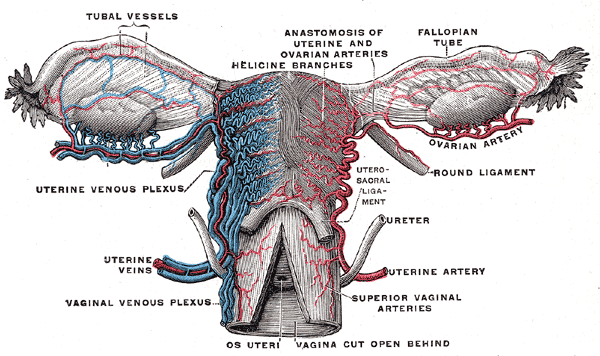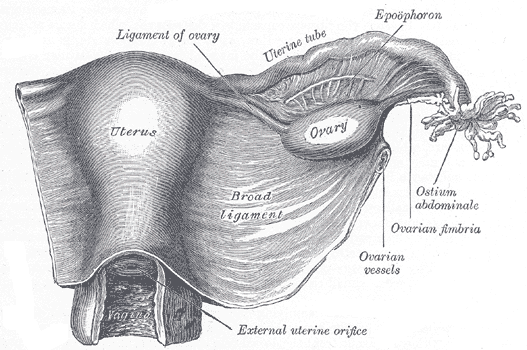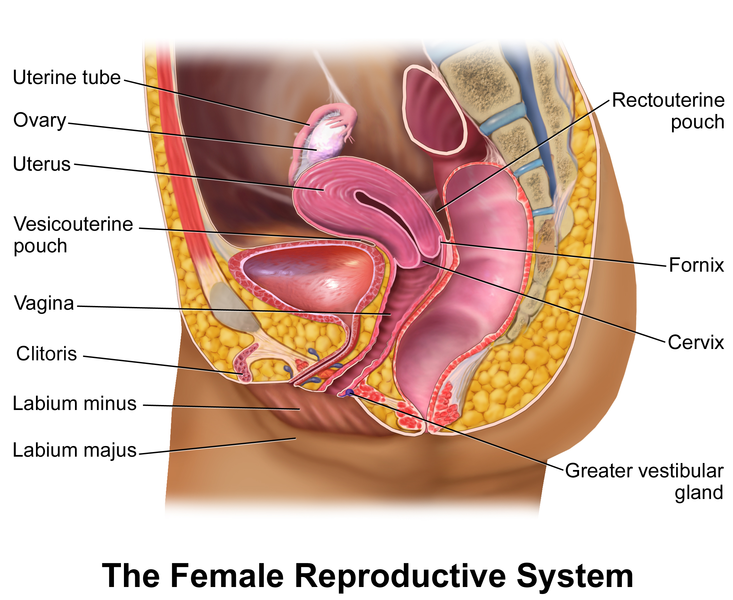[1]
Nizić D, Pervan M, Kos I, Šimunović Marko. [Flexion and version of the uterus on pelvic ultrasound examination]. Acta medica Croatica : casopis Hravatske akademije medicinskih znanosti. 2014 Jun:68(3):311-5
[PubMed PMID: 26016224]
[2]
Cagnacci A, Grandi G, Cannoletta M, Xholli A, Piacenti I, Volpe A. Intensity of menstrual pain and estimated angle of uterine flexion. Acta obstetricia et gynecologica Scandinavica. 2014 Jan:93(1):58-63. doi: 10.1111/aogs.12266. Epub 2013 Dec 3
[PubMed PMID: 24116846]
[3]
Mihu D, Mihu CM. Ultrasonography of the uterus and ovaries. Medical ultrasonography. 2011 Sep:13(3):249-52
[PubMed PMID: 21894299]
[4]
Roach MK, Andreotti RF. The Normal Female Pelvis. Clinical obstetrics and gynecology. 2017 Mar:60(1):3-10. doi: 10.1097/GRF.0000000000000259. Epub
[PubMed PMID: 28005593]
[5]
Park HJ, Kim YS, Yoon TK, Lee WS. Chronic endometritis and infertility. Clinical and experimental reproductive medicine. 2016 Dec:43(4):185-192. doi: 10.5653/cerm.2016.43.4.185. Epub 2016 Dec 26
[PubMed PMID: 28090456]
[6]
Catenaccio E, Mu W, Lipton ML. Estrogen- and progesterone-mediated structural neuroplasticity in women: evidence from neuroimaging. Brain structure & function. 2016 Nov:221(8):3845-3867
[PubMed PMID: 26897178]
[7]
DeMayo FJ, Zhao B, Takamoto N, Tsai SY. Mechanisms of action of estrogen and progesterone. Annals of the New York Academy of Sciences. 2002 Mar:955():48-59; discussion 86-8, 396-406
[PubMed PMID: 11949965]
[9]
Vervoort AJ, Uittenbogaard LB, Hehenkamp WJ, Brölmann HA, Mol BW, Huirne JA. Why do niches develop in Caesarean uterine scars? Hypotheses on the aetiology of niche development. Human reproduction (Oxford, England). 2015 Dec:30(12):2695-702. doi: 10.1093/humrep/dev240. Epub 2015 Sep 25
[PubMed PMID: 26409016]
[10]
Briceag I, Costache A, Purcarea VL, Cergan R, Dumitru M, Briceag I, Sajin M, Ispas AT. Fallopian tubes--literature review of anatomy and etiology in female infertility. Journal of medicine and life. 2015 Apr-Jun:8(2):129-31
[PubMed PMID: 25866566]
[11]
Coy P, García-Vázquez FA, Visconti PE, Avilés M. Roles of the oviduct in mammalian fertilization. Reproduction (Cambridge, England). 2012 Dec:144(6):649-60. doi: 10.1530/REP-12-0279. Epub 2012 Oct 1
[PubMed PMID: 23028122]
[12]
Migda MS, Migda M, Słapa R, Mlosek RK, Migda B. The use of high-frequency ultrasonography in the assessment of selected female reproductive structures: the vulva, vagina and cervix. Journal of ultrasonography. 2019 Dec:19(79):261-268. doi: 10.15557/JoU.2019.0039. Epub 2019 Dec 31
[PubMed PMID: 32021707]
[13]
Ernest A, Emmanuel M, Gregory K. Post-coital posterior fornix perforation with vaginal evisceration. BMC women's health. 2014 Nov 25:14():141. doi: 10.1186/s12905-014-0141-6. Epub 2014 Nov 25
[PubMed PMID: 25420670]
[14]
Ciebiera M, Słabuszewska-Jóźwiak A, Ledowicz W, Jakiel G. Vaginal foreign body mimicking cervical cancer in postmenopausal woman - case study. Przeglad menopauzalny = Menopause review. 2015 Sep:14(3):208-10. doi: 10.5114/pm.2015.54348. Epub 2015 Sep 30
[PubMed PMID: 26528112]
Level 3 (low-level) evidence
[15]
Lee IO, Lee JY, Kim S, Kim SW, Kim YT, Nam EJ. Sentinel lymph node mapping with indocyanine green in vaginal cancer. Journal of gynecologic oncology. 2017 Jul:28(4):e29. doi: 10.3802/jgo.2017.28.e29. Epub
[PubMed PMID: 28541627]
[16]
Hasanzadeh M, Jafarian AH, Mousavi Seresht L. Primary Clear Cell Carcinoma with no Diethylstilbestrol Exposure; Case Series. Iranian journal of medical sciences. 2019 Mar:44(2):163-167
[PubMed PMID: 30936603]
Level 2 (mid-level) evidence
[17]
Yao HH. The pathway to femaleness: current knowledge on embryonic development of the ovary. Molecular and cellular endocrinology. 2005 Jan 31:230(1-2):87-93
[PubMed PMID: 15664455]
[18]
Kleppe M, Kraima AC, Kruitwagen RF, Van Gorp T, Smit NN, van Munsteren JC, DeRuiter MC. Understanding Lymphatic Drainage Pathways of the Ovaries to Predict Sites for Sentinel Nodes in Ovarian Cancer. International journal of gynecological cancer : official journal of the International Gynecological Cancer Society. 2015 Oct:25(8):1405-14. doi: 10.1097/IGC.0000000000000514. Epub
[PubMed PMID: 26397066]
Level 2 (mid-level) evidence
[19]
Boyd CA, Riall TS. Unexpected gynecologic findings during abdominal surgery. Current problems in surgery. 2012 Apr:49(4):195-251. doi: 10.1067/j.cpsurg.2011.12.002. Epub
[PubMed PMID: 22424211]
[20]
Garge S, Paliwal G, Mittal S, Kakani N. Mesonephric Remnant (Paroophoron) Presenting as a Congenital Lumbar Sinus in a Child. Journal of Indian Association of Pediatric Surgeons. 2020 Jan-Feb:25(1):58-59. doi: 10.4103/jiaps.JIAPS_242_18. Epub 2019 Nov 27
[PubMed PMID: 31896904]
[21]
Peters A, Stuparich MA, Mansuria SM, Lee TT. Anatomic vascular considerations in uterine artery ligation at its origin during laparoscopic hysterectomies. American journal of obstetrics and gynecology. 2016 Sep:215(3):393.e1-3. doi: 10.1016/j.ajog.2016.06.004. Epub 2016 Jun 8
[PubMed PMID: 27287682]
[22]
Anderson D. Pudendal nerve block for vaginal birth. Journal of midwifery & women's health. 2014 Nov-Dec:59(6):651-659. doi: 10.1111/jmwh.12222. Epub 2014 Oct 7
[PubMed PMID: 25294258]
[23]
Ashton-Miller JA, DeLancey JO. Functional anatomy of the female pelvic floor. Annals of the New York Academy of Sciences. 2007 Apr:1101():266-96
[PubMed PMID: 17416924]
[24]
de Tayrac R, Panel L, Masson G, Mares P. [Episiotomy and prevention of perineal and pelvic floor injuries]. Journal de gynecologie, obstetrique et biologie de la reproduction. 2006 Feb:35(1 Suppl):1S24-1S31
[PubMed PMID: 16495824]
[25]
Kalis V, Chaloupka P, Turek J, Rokyta Z. [The perineal body length and injury at delivery]. Ceska gynekologie. 2005 Sep:70(5):355-61
[PubMed PMID: 16180795]
[26]
Sabbagh R, Mandron E, Piussan J, Brychaert PE, Tu le M. Long-term anatomical and functional results of laparoscopic promontofixation for pelvic organ prolapse. BJU international. 2010 Sep:106(6):861-6. doi: 10.1111/j.1464-410X.2009.09173.x. Epub 2010 Jan 19
[PubMed PMID: 20089111]
[27]
Weekes AR, Atlay RD, Brown VA, Jordan EC, Murray SM. The retroverted gravid uterus and its effect on the outcome of pregnancy. British medical journal. 1976 Mar 13:1(6010):622-4
[PubMed PMID: 1252851]
[28]
Dabrowiecki A, Newsome J, Bercu ZL, Martin JG. Postpartum haemorrhage requiring embolisation of a hypertrophied round ligament artery. BMJ case reports. 2019 Aug 30:12(8):. doi: 10.1136/bcr-2019-230071. Epub 2019 Aug 30
[PubMed PMID: 31473635]
Level 3 (low-level) evidence
[29]
Ambedkar V, Singh A, Bain J, Singh LM. A rare case of femoral herniation of female internal genitalia. Journal of natural science, biology, and medicine. 2015 Jul-Dec:6(2):454-6. doi: 10.4103/0976-9668.160038. Epub
[PubMed PMID: 26283851]
Level 3 (low-level) evidence
[30]
Sanders RC, Parsons AK. Anteverted retroflexed uterus: a common consequence of cesarean delivery. AJR. American journal of roentgenology. 2014 Jul:203(1):W117-24. doi: 10.2214/AJR.12.10403. Epub
[PubMed PMID: 24951223]
[31]
Albulescu D, Constantin C, Constantin C. Uterine artery emerging variants - angiographic aspects. Current health sciences journal. 2014 Jul-Sep:40(3):214-6. doi: 10.12865/CHSJ.40.03.11. Epub 2014 Aug 4
[PubMed PMID: 25729609]
[32]
Garcia-Ortiz JE, Pelosi E, Omari S, Nedorezov T, Piao Y, Karmazin J, Uda M, Cao A, Cole SW, Forabosco A, Schlessinger D, Ottolenghi C. Foxl2 functions in sex determination and histogenesis throughout mouse ovary development. BMC developmental biology. 2009 Jun 18:9():36. doi: 10.1186/1471-213X-9-36. Epub 2009 Jun 18
[PubMed PMID: 19538736]
[33]
Patil M. Assessing tubal damage. Journal of human reproductive sciences. 2009 Jan:2(1):2-11. doi: 10.4103/0974-1208.51335. Epub
[PubMed PMID: 19562067]
[34]
Lindquist JD, Vogelzang RL. Pelvic Artery Embolization for Treatment of Postpartum Hemorrhage. Seminars in interventional radiology. 2018 Mar:35(1):41-47. doi: 10.1055/s-0038-1636520. Epub 2018 Apr 5
[PubMed PMID: 29628615]
[35]
Chen C, Lee SM, Kim JW, Shin JH. Recent Update of Embolization of Postpartum Hemorrhage. Korean journal of radiology. 2018 Jul-Aug:19(4):585-596. doi: 10.3348/kjr.2018.19.4.585. Epub 2018 Jun 14
[PubMed PMID: 29962865]
[36]
Soeta N, Saito T, Nemoto T, Oshibe I, Gotoh M. Laparoscopic repair of irreducible femoral hernia containing the fallopian tube alone: a case report. Surgical case reports. 2016 Dec:2(1):57. doi: 10.1186/s40792-016-0185-y. Epub 2016 Jun 6
[PubMed PMID: 27271469]
Level 3 (low-level) evidence
[37]
Coyle D, Kavanagh N, Mahmoud A, Lowery AJ, Khan W, Barry K. Incarcerated femoral hernia containing ovary and fallopian tube in a 54-year-old. BMJ case reports. 2011 Aug 4:2011():. doi: 10.1136/bcr.05.2011.4263. Epub 2011 Aug 4
[PubMed PMID: 22687676]
Level 3 (low-level) evidence
[38]
Giarenis I, Robinson D. Prevention and management of pelvic organ prolapse. F1000prime reports. 2014:6():77. doi: 10.12703/P6-77. Epub 2014 Sep 4
[PubMed PMID: 25343034]
[39]
Chung SH, Kim WB. Various Approaches and Treatments for Pelvic Organ Prolapse in Women. Journal of menopausal medicine. 2018 Dec:24(3):155-162. doi: 10.6118/jmm.2018.24.3.155. Epub 2018 Dec 31
[PubMed PMID: 30671407]



